
This article was updated on November 11th, 2023

A red, swollen or irritated ‘rear end’ in dogs can be alarming. It causes discomfort and may lead to your dog excessively licking, chewing or scooting. In this article, we will discuss the most likely reasons, when to worry, and what you can do at home to help while waiting for your vet appointment.
Mild redness may improve with no intervention
“Mild cases of red and irritated bottoms rarely require urgent veterinary intervention. If your dog is otherwise acting normal with no signs of illness, mild inflammation often improves with little to no intervention.”
Symptoms of a mildly irritated anus in dogs include redness and some discomfort, but no obvious and excessive signs of pain or behavior changes.
What’s an example of a mild anal inflammation?
Here is a photo (Warning: graphic image) of mild anal inflammation in a dog. For this severity of illness, a wait-and-see approach is appropriate. Keeping your dog’s bottom (‘perineal region’) clean and free of fecal material will help prevent worsening irritation.
However, do not delay veterinary treatment if your dog is also showing these other signs of discomfort
“While mild redness may improve without treatment, red or inflamed bottoms may also be a sign of a medical condition that requires prompt veterinary help – for example allergies, parasites or anal gland infections.
If your dog is frequently scooting or tries to lick the affected area, or if you observe any swelling, discharge, odor or behavior changes, or if your dog is showing other signs of illness such as diarrhea, call your vet. Waiting too long could make things much worse.”
Common reasons your dog’s anus could be red or inflamed
Anal irritation in dogs is a common problem and usually the result of one of these conditions:
1. Diarrhea
Diarrhea is the most common cause of anal discomfort in dogs. It can often cause increased urgency to go to the bathroom and straining to defecate. This straining can cause worsening inflammation and discomfort of the colon and anus. Dogs with diarrhea may have fecal staining of their perineal region. The diarrhea is caustic due to the presence of gastric acids, digestive enzymes, and bile. This leads to redness and irritation of the anus. Read our Tips to Stop Diarrhea Fast.
2. Anal gland issues
Signs of anal gland disease may include excessive scooting on the floor, licking, or pain during defecation. Dogs have two anal glands situated on either side. These glands can become swollen or infected, as shown in the illustration below:
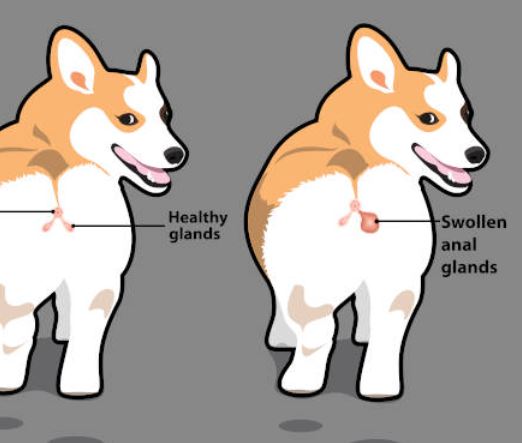
Infected anal glands will irritate the anus and cause local swelling and redness. (Rupture of the anal gland can also occur, leading to a wound and purulent discharge.) Read more: Anal Gland Infections.
3. Cancer
Just like humans, dogs can be predisposed to a variety of cancers. Anal gland adenocarcinoma is a cancerous process arising from the anal glands. It is relatively uncommon but is an aggressive cancer that can invade local tissues and metastasize. These tumors often appear as lumps next to the anus. Dogs with anal tumors may have difficulty defecating. You can click here to see a picture of an anal gland tumor or see another example here.
4. Allergies
A hallmark sign of flea allergies is itching and hair loss of the hind end, especially at the base of the tail. Dogs with allergies will often feel very itchy and experience red and irritated skin. Chronic allergies can lead to itching and hair loss around the perineal region. The pictures below show skin redness and irritation as a result of allergies:
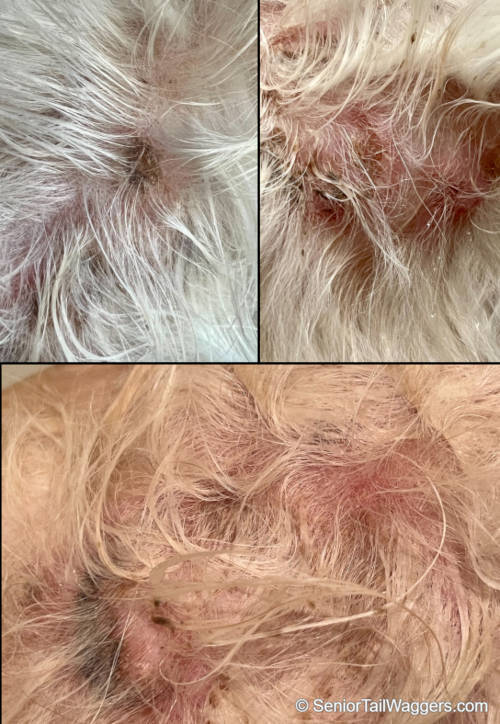
Dogs can be predisposed to allergies, whether it be to the environment, food, or parasites on the skin. Learn more about Allergies & Skin Rashes.
5. Rectal Prolapse
A rectal prolapse is when the inner surface of the rectum protrudes beyond the anus. The prolapsed tissue will appear bright red and may look similar to a swollen tube. See this image from PetCoach (warning – graphic image). The prolapse may be temporary and occur during a bowel movement. Sustained prolapses are an emergency. Dogs with chronic diarrhea, cancers, or parasites may be predisposed to rectal prolapse.
Learn more about Rectal Prolapses.
6. Perianal Fistulas
Perianal fistulas are caused by an auto-immune condition that leads to severe inflammation of the perianal region. Dogs with this condition develop tracts near the anus (often with a foul-smelling discharge), bleeding, straining to defecate, and significant pain. German Shepherds are predisposed to this condition. See this graphic picture.
Learn more about Perianal Fistulas.
4 tips to help your dog’s bottom at home
1. start by keeping the area clean
“Keeping the dog’s perineal region clean and free of fecal material will help prevent ulceration or worsening irritation. Wiping your dog’s bottom clean can prevent further irritation, in particular if your dog has diarrhea. “
How do you keep the area clean? You can gently wipe your dog’s bottom clean with toilet paper or wipes to help avoid further irritation. Our vets recommend the following wipes:
- SUPPORTS HEALTHY ANAL GLANDS & HYGIENE - Convenient soft & durable dog wipe for daily hygiene can be used all over body, on paws coat face ears & anal area. Great for dogs and cats of all ages.
2. Soothe sore skin
For mild cases, there are ways to help soothe your dog’s red or irritated bottom while you wait for your vet appointment.
“Over-the-counter topical treatments can be used in mild cases to calm irritated or ulcerated skin. Products that are safe to use include Vaseline and Aquaphor. These ointments help heal inflamed skin and also create a barrier to prevent further irritation. Do not allow your dog to lick the area after ointment has been applied.”
Products that are safe to use in mild cases include Vaseline and Aquaphor:
- This creamy, non-drying formula leaves skin feeling clean, velvety, and rebalanced
3. Give your dog a bland diet (if your dog has diarrhea)
Diarrhea is one of the most frequent causes of irritated bottoms in dogs. If your dog is also experiencing mild diarrhea, the easiest and most effective treatment is changing meals to a bland diet. This diet typically consists of boiled chicken or lean ground beef mixed with white rice. Learn more: tips to help with dog diarrhea.
4. Consider an e-collar if your dog is excessively licking their rear end
“Dogs with anal irritation will feel the need to lick and chew the perineal region. These behaviors will only lead to worsening discomfort and inflammation.”
An Elizabethan collar is an excellent solution to prevent your dog from further traumatizing its anus:
Some dogs with an irritated bottom may need urgent veterinary care
“Dogs with signs of ongoing diarrhea, pain, bleeding when defecating, masses, lumps or black/tarry stools require urgent veterinary intervention. Waiting may lead to more discomfort and more pain for your dog.”
Inflammation and redness around the anus are always concerning to pet owners. Even so, they are not always an emergency. The following clinical signs indicate that urgent or emergent intervention is required:
- Defecating large amounts of blood: A very small amount of blood in the stool is not overly concerning. A larger amount of blood in poop is a sign of significant inflammation of the colon or damage to the local blood vessels. A veterinarian should always address this.
- Rectal prolapse: Rectal prolapse is a medical emergency and delaying treatment can cause necrosis and require emergency surgery.
- Pain: Any dog with signs of pain or discomfort should be evaluated by a veterinarian as soon as possible. Pain may cause a reluctance to defecate, leading to constipation if untreated.
- Lumps: If your dog has a lump near the anus, it’s important to see a vet ASAP. Early diagnosis of perianal masses can lead to better recovery.
- Perianal fistulas: If you are concerned that your dog has a perianal fistula, urgent intervention is recommended. Catching the disease in its early phases will allow quicker and more effective treatment.
Your vet can perform a physical exam & analyze a fecal sample to confirm diagnosis
At the veterinary office, a series of steps will take place to determine the cause of your dog’s irritated or swollen anus. Your veterinarian will likely:
- Perform a physical examination. Part of this physical examination will include a rectal exam. This exam is used to determine if there are any abnormalities of the anus, anal glands, or stool.
- Request a fecal sample to evaluate for gastrointestinal parasites or overgrowth of bacteria.
If the anal glands are swollen, expression may be performed to alleviate discomfort. In the event of an anal gland impaction or abscess, your dog may need to be sedated to have the anal gland drained.
If there is a concern for an anal gland mass, fine needle aspirates are recommended to evaluate if cancerous cells are present.
Once a definitive diagnosis is made regarding the cause of your dog’s anal irritation, a targeted treatment plan will be discussed. Depending on the cause, this may include:
- Medication or probiotics to improve diarrhea
- Pain medication
- Treatment of allergies
- Deworming agents to eliminate gastrointestinal parasites
Dogs with perianal masses should have them surgically removed once staging has been performed. Dogs with perianal fistulas or allergies may require treatments with immunosuppressive agents.
Take pictures and consider bringing a fecal sample to your vet
Before your veterinary visit, make sure you have any information handy that your veterinarian may need. This includes a timeline and details of the clinical signs as they appeared.
Take photos of the perineal region or feces. They may help the doctor have a better sense of what is going on. You should also bring a fresh fecal sample, which will facilitate testing for parasites or bacterial overgrowth.
FAQ
1. Why is my dog’s anus swollen and protruding?
If you are noticing these signs in your dog, there could be many causes, including anal sac issues, tumors, and infections. Rectal prolapses are also possible.
2. Why is my dog’s anus only red after pooping?
A red anus after defecation may be normal in some dogs as their rectal mucosa can protrude slightly after a bowel movement. Moreover, straining to defecate, diarrhea, and constipation can cause redness after defecating.
3. What foods help dogs express their anal sacs?
If your dog has chronic anal sac issues, you should talk to your vet. Increasing fiber can bulk up the stool and may aid the dog in expressing the sacs when they defecate. Canned pumpkin may be a good addition to your dog’s diet. Read more: Is Pumpkin Truly a Miracle Food for Anal Gland Issues?
Related posts:
Disclaimer: This website's content is not a substitute for veterinary care. Always consult with your veterinarian for healthcare decisions. Read More.









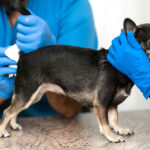

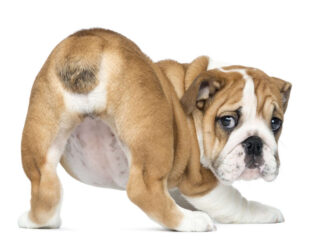
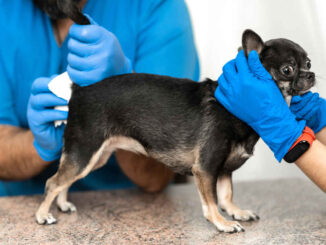

Be the first to comment